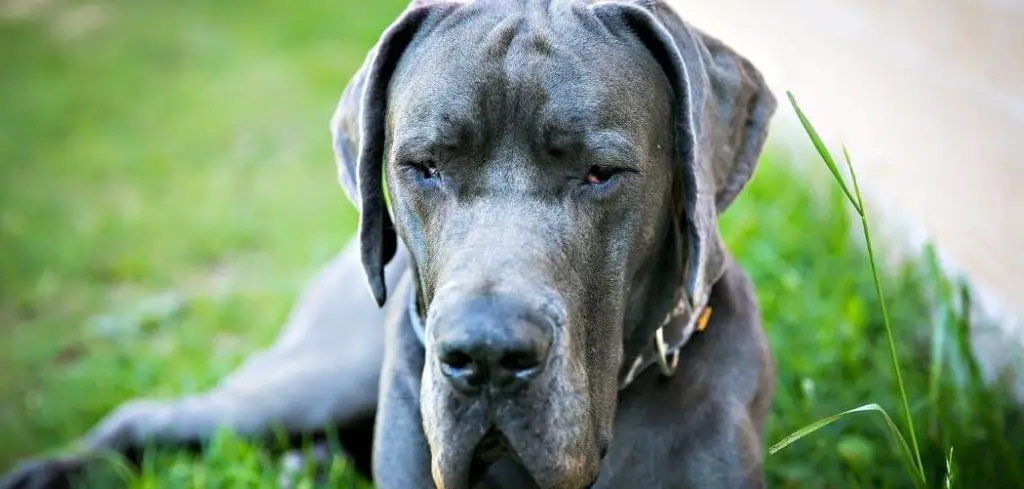Dogs licking and panting can sometimes be normal, but when the behavior becomes excessive, it may signal something more serious.
Owners often worry when their dog can’t seem to stop licking and is also panting heavily, since these symptoms together may point to underlying health or behavioral issues.
We outline the common reasons why a dog may excessively lick and pant, what you can do at home, and when to seek veterinary help.
Dog Excessively Licking and Panting — Why It Happens
When a dog is both excessively licking and panting, it’s often a sign of discomfort, anxiety, or a medical condition. This combination may be caused by heatstroke, nausea, allergies, pain, or even stress-related behaviors. Some dogs lick compulsively as a way to soothe themselves, while panting often signals either overheating or underlying illness.
These symptoms may also appear together in cases of gastrointestinal upset, poisoning, or respiratory disease, making it important not to dismiss them.

Dog Excessively Licking and Panting: Common Causes
Heatstroke
When a dog overheats, panting is the body’s main way of cooling down. Excessive licking may also appear as the dog tries to cope with discomfort.
Owners may notice drooling, restlessness, weakness, or collapse. Heatstroke is especially common in hot weather, with short-nosed breeds like Bulldogs or Pugs being more vulnerable.
This condition is life-threatening, and immediate action is required to bring the dog’s temperature down safely while seeking veterinary care.
Read more: Dog Excessively Licking and Gagging (When it’s more than an itch)
Nausea and Gastrointestinal Upset
A nauseous dog may lick their lips or surfaces excessively as a self-soothing behavior. Panting can accompany this due to discomfort or abdominal pain.
Signs include drooling, eating grass, vomiting, or restlessness. Gastrointestinal upset may be caused by infections, dietary indiscretion, pancreatitis, or ingestion of toxins.
When licking and panting are combined with vomiting or diarrhea, it suggests the dog’s system is under significant stress and may need urgent evaluation.
Pain or Injury
Dogs often lick at an area of their body when in pain, and panting is another common pain response.
This may happen with joint problems, injuries, dental pain, or internal discomfort. Owners may also notice restlessness, changes in posture, or whining.
Because dogs instinctively hide pain, excessive licking and panting may be one of the few outward clues that something is wrong.
Anxiety or Stress
Excessive licking can be a compulsive behavior linked to anxiety. Panting is also a stress signal, even when the environment is not hot.
This may occur during thunderstorms, fireworks, car rides, or when the dog is left alone. Other signs include pacing, whining, trembling, or destructive behavior.
While stress responses are not immediately life-threatening, chronic anxiety takes a toll on a dog’s health and quality of life if left unmanaged.
Allergies or Skin Irritation
A dog with itchy skin may lick excessively, sometimes focusing on the paws or belly. Panting can appear alongside this due to discomfort or secondary infection.
Allergies may be seasonal, food-related, or triggered by environmental factors like dust mites or fleas. Owners may notice redness, hair loss, or constant scratching.
If the irritation becomes severe, dogs may cause open sores or hotspots from the licking, creating a cycle of worsening symptoms.
Poisoning or Toxin Exposure
Some toxins cause drooling, excessive licking, and panting as early symptoms. Substances like chocolate, xylitol, certain plants, or household chemicals may trigger this response.
Other signs may include vomiting, diarrhea, shaking, seizures, or collapse.
Because toxin exposure can become fatal quickly, urgent veterinary care is required if this cause is suspected.
What to Do If Your Dog Is Excessively Licking and Panting
If a dog is showing these behaviors, first check the immediate environment. Make sure the dog is not overheating, and move them to a cooler, shaded area with water available.
Look for signs of injury, skin irritation, or anything unusual the dog may have eaten. Sometimes identifying the source quickly can help prevent worsening symptoms.
Provide comfort and reassurance if stress or anxiety is suspected. Keeping the dog in a calm, safe space and removing stress triggers can help reduce panting and licking.
Avoid scolding or punishing the behavior, as this may increase anxiety. Instead, monitor closely and keep track of any additional symptoms that may develop.
If the dog is persistently uncomfortable, it’s best to arrange a veterinary visit even if the signs seem mild.
When to Call or Visit Your Vet
Seek immediate veterinary care if licking and panting are accompanied by vomiting, diarrhea, drooling, shaking, or collapse. These may indicate poisoning, heatstroke, or gastrointestinal disease.
If the dog is struggling to breathe, appears weak, or seems unable to settle, emergency attention is needed.
Chronic but less severe cases, such as those linked to allergies or stress, should still be discussed with a veterinarian. Persistent licking can lead to secondary infections, while panting without obvious cause may point to hidden illness.
Any sudden change in a dog’s behavior, especially when symptoms appear together, deserves professional evaluation.
Read more: Dog licking excessively (Discover what it might mean)
Key Takeaway
Excessive licking and panting in dogs is not just a quirky behavior but often a sign of discomfort, illness, or stress. Causes range from heatstroke and nausea to allergies, anxiety, or even poisoning.
Owners can help by providing comfort, checking for environmental triggers, and seeking prompt veterinary care when needed. Early recognition makes a significant difference in protecting a dog’s health and well-being.
If a dog is showing both of these behaviors, trust your instincts. When in doubt, a timely vet visit is always the safest choice.
